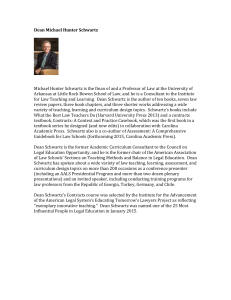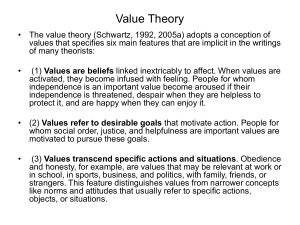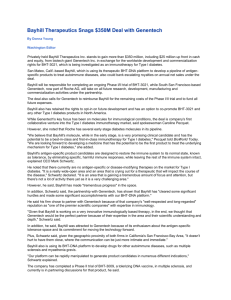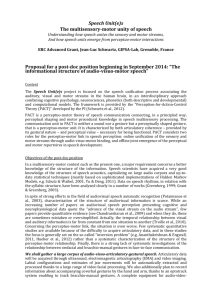Market: Failure to understand “linkage”
advertisement
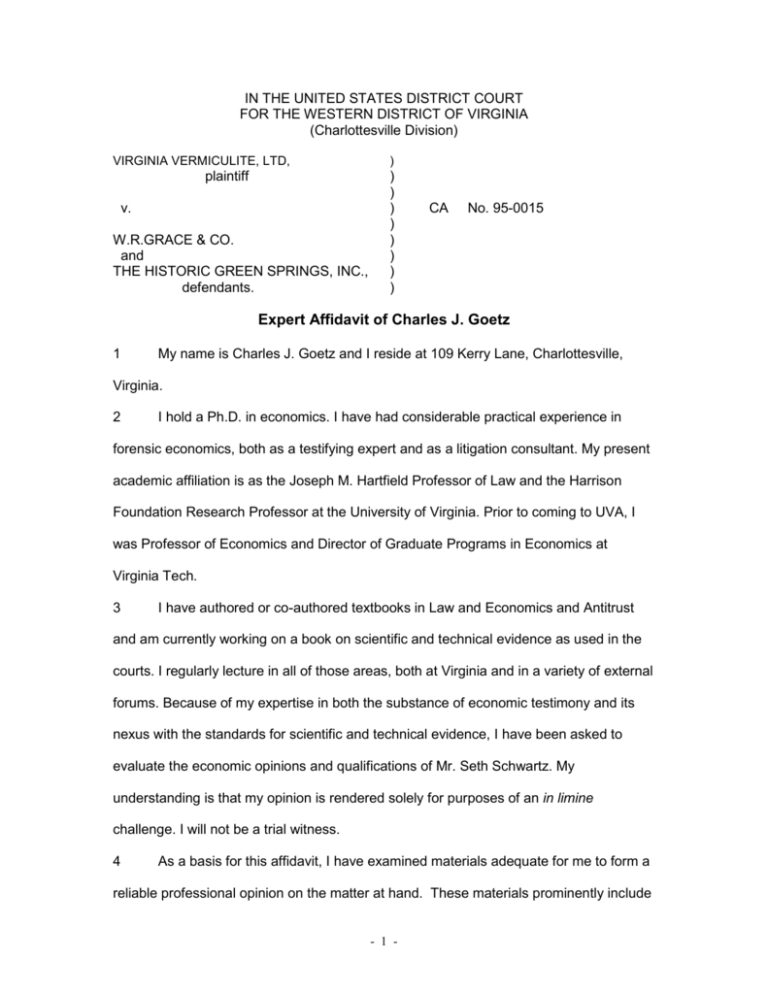
IN THE UNITED STATES DISTRICT COURT FOR THE WESTERN DISTRICT OF VIRGINIA (Charlottesville Division) VIRGINIA VERMICULITE, LTD, plaintiff v. W.R.GRACE & CO. and THE HISTORIC GREEN SPRINGS, INC., defendants. ) ) ) ) ) ) ) ) ) CA No. 95-0015 Expert Affidavit of Charles J. Goetz 1 My name is Charles J. Goetz and I reside at 109 Kerry Lane, Charlottesville, Virginia. 2 I hold a Ph.D. in economics. I have had considerable practical experience in forensic economics, both as a testifying expert and as a litigation consultant. My present academic affiliation is as the Joseph M. Hartfield Professor of Law and the Harrison Foundation Research Professor at the University of Virginia. Prior to coming to UVA, I was Professor of Economics and Director of Graduate Programs in Economics at Virginia Tech. 3 I have authored or co-authored textbooks in Law and Economics and Antitrust and am currently working on a book on scientific and technical evidence as used in the courts. I regularly lecture in all of those areas, both at Virginia and in a variety of external forums. Because of my expertise in both the substance of economic testimony and its nexus with the standards for scientific and technical evidence, I have been asked to evaluate the economic opinions and qualifications of Mr. Seth Schwartz. My understanding is that my opinion is rendered solely for purposes of an in limine challenge. I will not be a trial witness. 4 As a basis for this affidavit, I have examined materials adequate for me to form a reliable professional opinion on the matter at hand. These materials prominently include - 1 - the important pleadings and economic depositions and reports, notably those of Schwartz, Godek, and Mills. I have assumed that Schwartz’s reports were intended and required to contain a complete statement of all opinions to be expressed at trial with the reasons and basis therefor. 5 In the remainder of this affidavit, I develop the reasons why, in my professional opinion, the following things are true: (1) Mr. Schwartz does not meet the minimum standard of specialized economic knowledge required to render a reliable opinion on the economic issues of this case. Because of his lack of sophistication in economic analysis and the implementation thereof, his erroneous interpretations of the market phenomena in this case would not only not be helpful to the jury, but would actually be misleading. (2) Even if it were deemed that Mr. Schwartz met the threshold expertise qualification, the actual analysis that he has carried out does not satisfy the relevant standards of professional rigor that would have to apply in order to render the important economic conclusions that he reaches. 6 My analysis in this affidavit focuses on examples of Mr. Schwartz’s conclusions that are so methodologically incomplete that any competent economist ought to agree about their lack of sound basis or where, in my professional opinion, he either misapplies or is incapable of applying an analytical tool required to reliably reach his conclusions. (Schwartz offers other analyses with which I may disagree on other grounds.) 7 In my experience both as a practicing forensic economist and as a scholar who follows both antitrust and scientific evidence litigation, I do not recall any other attempt by a party to use an expert lacking formal economic analysis training to proffer crucial opinions on complex economic issues such as market definition, market power, competitive injury, etc. It is also extremely unusual for a party to select an expert - 2 - witness who is susceptible to the allegations of bias that arise out of that witness’s close business and personal ties with the party. In candor, the combination of both of these circumstances here, together with the strained nature of Mr. Schwartz’s analysis and conclusions, creates for me an inference that plaintiff may have had difficulty in finding a qualified neutral expert who would testify to the same opinions. 8 Since Mr. Schwartz has neither formal training in economics nor any background in vermiculite marketing, one is compelled to judge his qualifications by a performance test. I do not find his claimed record of job experience in merger analysis to be persuasive alternative support for a claim of expertise.1 However, I base my opinion about his qualifications principally on the lack of analytic competence actually evidenced in his Report, his Rebuttal and Supplemental Report, and his deposition testimony. Therefore, my opinion about Mr. Schwartz’s qualifications is necessarily intermingled below with my identification of the methodological flaws in his analysis. His analysis is not just wrong; rather, his conclusions just do not make good economic sense. 9 The fundamental methodology of economics and that of the more “hard” sciences is parallel in the respects that are relevant here. First, the analyst must properly identify the alternative hypotheses about the phenomena being studied. Second, the analyst identifies and carries out the necessary empirical “tests” that might support or disprove the competing hypotheses. Third, the tests are interpreted and, in the light of their results, an opinion is generated about the validity of the competing hypotheses. How economic experts analyze markets and economic behavior is, therefore, scientifically analogous to how physicians engage in the “differential diagnosis” implicated in the landmark Daubert case. The validity of any expert’s opinion 1 In part, this is because the exact nature of this experience and the quality of his performance has not been subjected to scrutiny. For instance, Mr. Schwartz might in the future adduce his work on this case as qualifying experience as an opinion testifier. However, experience that does - 3 - depends, of course, on the careful and competent completion of each of the steps described above. This affidavit provides examples of how Mr. Schwartz’s analysis contains defects in each of these essential steps. 10 The linchpin of Mr. Schwartz’s claim that Grace has market power is an alleged successful exercise of monopoly power by Grace in the mid-1990s.2 Schwartz’s avowed conceptual test for market power is based upon a methodology derived from the DOJ Merger Guidelines. The test also has implications for Schwartz’s market definition analysis. This test hinges on the ability of a vendor profitably3 to raise price above the competitive price for a significant period. Schwartz points to a period of considerable increase in Grace’s prices, an increase that he contends satisfies the test for market power. As outlined below, however, he was apparently incapable of framing and properly testing alternative hypotheses that plausibly explain the same market observations in a manner that provides no basis for an inference of market power. 11 There can be no doubt that the price-increase test contemplates a vendor- actuated movement (by constraining supply) along a single identifiable demand curve.4 The price and quantity combinations that Schwartz cites as a basis for his opinion are, however, merely a series of intersections between pairs of demand and supply curves existing at the time of each observation. An observed price increase can, therefore, be caused by a rightward shift of the demand curve, a leftward shift of the supply curve, or not demonstrably comply with professional standards can, in my opinion, have little if any weight as a qualification. 2 The statement of this theory is in his Report at 6-8. In addition to the purported actual exercise of price power, Schwartz also alleges the power of Grace to “exclude competition” as support for his market power opinion. The acknowledged fact that no competition has in fact yet been excluded, and the lack of proof that it ever will be, is addressed in the section discussing “harm to competition,” starting at ¶27 below. 3 In the text here, I address only whether the pricing experiment used by Schwartz is framed in a manner consistent with the DOJ criterion that he espouses. An independent requirement is that the price increase be profitable, as opposed to a loss-minimizing reaction to changes in costs or other market conditions. Dr. Godek argues persuasively that Schwartz ignores clear evidence in one of Schwartz’s own statistical tables that the price increase does not in fact satisfy the profitability criterion. Godek deposition at 80-81. - 4 - some combination of movement by both curves. Without more, it is simply a non sequitur to attribute an observed price increase to a single vendor’s conduct rather than, for instance, an independent demand-shift or supply-shift, neither of which implicates market power. This ambiguity has long been well-known in empirical economic analysis as the “identification problem” and requires both additional information and a sophisticated analytical technique to disentangle.5 As applied to the case, this is more than a mere theoretical objection because of the indisputable evidence that both supply and demand curves were indeed in substantial flux. 12 Mr. Schwartz’s failure to cope with the identification problem also infects his market-definition analyses. For instance, he asserts that “The increase in mid-sized concentrate sales volume…in the face of sharply rising prices [from 1992 to 1998] shows that the market for this product is not constrained by substitutes for exfoliated mid-sized vermiculite.”6 Unfortunately, that inference is valid only if one can establish that the demand curve for mid-sized vermiculite had not shifted upward over the same period, and the hypothesis that it did shift is, once again, supported by compelling evidence.7 Any analyst conversant with the identification problem would recognize that Mr. Schwartz’s inference from the data is not scientifically justifiable. 13 Mr. Schwartz admits to not being knowledgeable about the identification problem.8 Not possessing the requisite economic sophistication even to frame the plausible alternative hypotheses involving demand or supply shifts, he of course 4 Schwartz acknowledges this in his deposition at 367-368. The early and classic article is E.J. Working, “What Do Statistical ‘Demand Curves’ Show,” 41 Q. J. Econ. 212 (#2, 1927). 6 Report at 18. 7 Some of this evidence is very simple. Since demand curves are negatively sloped, price increases along a stable demand curve always produce a diminution in the quantity demanded. Examining Schwartz’s own data in the attachments to his Rebuttal, however, we can see that quantity demanded increases during the period of the price increase that he tries to interpret as proof of market power. The correct inference is that the market demand curve is evidently shifting rightward. 8 Deposition at 367. 5 - 5 - performed no tests that could give him an adequate scientific basis to exclude their influence on his conclusions. Even after the identification problem was broached at his deposition, Schwartz declined to acknowledge this—or indeed any other—flaw in his analysis.9 He therefore intends to testify to the jury about inferences that no competent economic analyst would accept as demonstrable on the same evidence and reasoning that Schwartz adduces. 14 His reports and testimony suggest to me, in any event, that Schwartz is not economically sophisticated enough to perform the supply-side analysis of price determination in standard market types, even if he had recognized what needed to be done. For instance, he did not perceive the relevance of the joint product10 phenomenon to what was transpiring in the vermiculite market and, indeed, admitted his lack of knowledge as to how joint products affect the competitive determination of price.11 He also admitted a lack of any knowledge about the “dominant firm model,”12 which is a standard economic model whose explanatory applicability to this case needed to be tested. Moreover, he was unable knowledgeably to discuss the factors that need to be held constant in determining supply curves and demand curves. Among the factors that need to be held constant in determining a demand curve are the prices of substitutes and complements. Schwartz admits to having done no investigation of the prices of the 9 Deposition at 437-438. Joint products exist when two or more saleable products are linked in a single unit of physical production. The production of cows, for instance, is the basis of the textbook “Beef and Hides” example. In similar manner, the different particle sizes (grades) of vermiculite appear in the mined material in a ratio fixed by Nature. One example of the direct relevance to this case is what Schwartz calls the “mine imbalance” experienced by Grace in its South Carolina operation; the mined material was not yielding particle sizes in the expected/desired ratio. When this variation in the joint product process is properly incorporated into an economic model, it represents a supply curve shift. In addition to the shifting demand curves, therefore, this cost-side phenomenon is yet another explanation for the price increase that Schwartz attributes to market power. 11 Deposition at 361-361. 12 Deposition at 384. 10 - 6 - substitutes and complements.13 Without doing this analysis, one cannot have good grounds to opine on the causes for observed pricing behavior that very plausibly were caused by demand shifts. Indeed, reliable inferences about the very existence of substitutability cannot be made without an appropriate examination of the prices of other products that at least plausibly are substitutes or complements. 15 I should mention that, in any event, Mr. Schwartz also apparently misunderstands the very concept of price-setting “market power” that is relevant to antitrust offences. He attributes an erroneous significance to the fact that Grace’s management could announce the company’s vermiculite prices, as opposed to the price being set by the market itself.14 If his understanding were correct, every supermarket, drugstore, and restaurant that determines its own posted prices would satisfy the market-power requirement of an antitrust violation. The fact is, power to post prices does not equate to monopoly power except when the firm’s discretion over its price is not adequately disciplined by external market forces. 16 A fundamental aspect of the economic analysis of market boundaries is the notion of substitutability. It is notable that Mr. Schwartz’s original Report did not contain the type of substitutability analysis that one would ordinarily expect. In response to criticisms from the opposing experts, Schwartz’s Rebuttal now provides a substitutes analysis whose defects are discussed in part below. In my opinion, however, Schwartz’s initial failure to provide this keystone element of market definition analysis suggests an inadequate grounding in the methods and expertise necessary to render an expert opinion in an antitrust case. 13 With respect to substitutes, he denies that there are any that need to be considered (against, in my view, a persuasive showing that this is untrue). He classifies some substances as complements, but has not studied their pricing over time. Deposition at 381-382. 14 Deposition at 272. - 7 - 17 Mr. Schwartz does not seem to appreciate the critical role played by the economic phenomenon that I shall here discuss as the “linkage” principle. This lack of understanding infects his market definition analysis, an analysis that depends critically on “end uses.” Even assuming arguendo that he has identified instances of individual end-uses for which there are no “good substitutes” for vermiculite, he attributes unwarranted importance to this in believing that he has thereby established that price increases would not be effectively disciplined by the marketplace. In fact, purchasers with inelastic demands for a product are potentially protected by their linkage in the market to other sets of consumers with a great capacity to substitute away. In short, exploiting the vulnerable means losing the flexible user. Even if the inelastic demanders are quantitatively dominant at the existing price, flight by a highly sensitive sub-set of demanders can discipline an attempted price increase. Of course, Schwartz’s opinions do not reflect an assessment of this very important factor. Therefore, his “end uses” methodology does not permit him to test market boundaries in a scientifically sound manner. 18 One notable place in which the linkage principle invalidates Schwartz’s analysis is his contention that vermiculite mining rights in Louisa County are a relevant geographic market. As I understand it, he believes that the mere fact that VVL has to buy there15 establishes this as an antitrust market.16 This is a classic non sequitur. An analogy makes the error of Schwartz’s argument apparent. Suppose there were a handful of University of Virginia professors who, for reason of health or otherwise, absolutely had to reside within a quarter-mile of the University grounds. Could even a monopolist that owned all of the housing within a quarter-mile radius successfully charge 15 Although I question the foundation for this factual premise as well, I accept it in the interests of exposing the more fundamental underlying error of economic theory. 16 Rebuttal at 32. The argument in the text above applies, mutatis mutandis, to the Peers’ selling “market” as well. - 8 - a monopoly price? It is not difficult to understand that such a seller’s ability profitably to raise price would depend on the (unlikely) additional showing that exploiting the vulnerable subset of buyers adequately compensates for losing the mobile buyers. Schwartz chooses to rely on a simplistic argument that, without more, simply does not provide an economically valid basis for his opinion about the Louisa “market”. 19 As already implied above, linkage applies in the product market as well as the geographic market. It applies, moreover, not only with respect to substitutability between vermiculite and other competing substances, but also among the different “grades” of vermiculite. Again, an analogy helps clarify the underlying theoretical point. It may well be true that competition from the lowest-cost Chevy does not constrain the pricing of a Mercedes. Nevertheless, an attempt to define an antitrust market in terms of quality variations in automobiles would run afoul of the reality that there is a spectrum of gradations between the extremes and, at every point on that spectrum, the purchasers with inflexible preferences are protected by potential flight of more flexible purchasers in either an upward or downward direction. Whether the different grades of vermiculite constitute different antitrust markets implicates the same issues, and these issues are inadequately explored. [Paragraphs discussing pricing data are redacted.] 23 Pages 358ff of the Schwartz deposition cover Mr. Montange’s attempt to ascertain whether Mr. Schwartz was knowledgeable enough to recognize that a persuasive hypothesis about the flat prices of Grades 4 and 5 as the supply curve shifts is this: the associated demand curves are also very flat. When Schwartz did not recognize this implication,17 Montange in essence walked Schwartz through the 17Deposition at 357: Q. If the price remains constant, the quantity -- and the quantity supplied changes over time in the market, what does that imply about demand?” . . . - 9 - appropriate diagrammatic model and eventually elicited Schwartz’s concession that the demand curves were indeed likely flat, i.e., very elastic. Elastic demand curves are well recognized as powerful evidence that there exist very good substitutes for the product in question. Astonishingly, however, Mr. Schwartz placed precisely the opposite interpretation on this market test of substitutability, claiming that this evidence implies no substitutes for these grades of vermiculite.18 An error so egregious regarding such a central point of the antitrust-relevant body of economic theory is a strong indictment of Mr. Schwartz’s claim to be an expert having the requisite ability to analyze and interpret market results in a manner that could be helpful to a jury. 24 Schwartz’s position that there are “no good substitutes” for vermiculite in the “markets” that he defines is contrary to the consensus of neutral industry observers opining in a non-litigation context.19 In a later section of this affidavit, I address in a more THE WITNESS: It doesn't suggest anything about demand other than that demand equals supply. 18Deposition at 360: Q. Now, if it were perfectly elastic relative to price, would that have any implication in your mind with respect to the availability of substitutes? A. It would imply that there were no substitutes for the product because the market would use whatever was supplied at that price. Q. It would imply no substitutes? A. That's right. 19 For instance, at about the time that I first heard about this litigation, I recall finding the following news note in Chemical Week, February 22, 1995, at p. 43.: A change in business strategy by W. R. Grace (Boca Raton, FL) -- the major U.S. producer of vermiculite, a hydrous silicate used in construction and agriculture -- has been a major factor in the drop in U.S. vermiculite output, says Roskill (London). Grace has reformulated its Monokote cement additive to a polystyrene-based product, sold its subsidiary Grace Sierra Horticultural Products, and transferred some of its mining rights to a historical preservation organization, thus removing large vermiculite reserves from future development. However, Roskill says the need to remain cost effective against alternative materials is likely to be the main factor determining the future pricing of vermiculite, and prices are likely to remain steady. Roskill, the information service quoted in the article, is a respected trade source. The vermiculite expert chosen by Roskill to write its most recent proprietary report on vermiculite is Graham Ellicott. Ellicott’s expert report and deposition testimony in this case provides detail on numerous competitive substances that substitute for vermiculite. Almost 5 years after the Chemical Week article, professionals writing in the industry journals do not appear to have changed their opinion regarding competition. Alison Russell, identified as an “independent consultant,” observes the following in a recent article in the Mining Journal, October 1, 1999, at p. 138: - 10 - general way my professional opinion that the overall pattern of citations of deposition testimony, and personal conversations, and other evidence cited by Schwartz is so onesidedly selective and uncritical as to violate an expert’s “evaluative” obligation with respect to foundational data.20 At minimum, however, an analyst cannot have good grounds for his conclusion when he unreasonably ignores a major marketplace event that seems to be inconsistent with the conclusion that vermiculite constitutes a separate product market with highly inelastic demand. As Dr. Godek points out, the closure of Grace’s Libby operation effectively represents a very substantial leftward shift of the industry supply curve. If the demand for vermiculite was truly inelastic, one would have expected this “natural experiment,” as Godek terms it, to produce enormous price increases and other market consequences that did not materialize.21 It is not consistent with acceptable methodology for an analyst simply to ignore major evidence that counters his position. Moreover, this natural experiment is directly relevant in that it mirrors the mechanism—a supply cutback—that a monopolist exercising market power would have to employ. 25 Mr. Schwartz’s tendency to couch his opinions in extreme, unqualified terms (such as the utter absence of economically relevant substitutes and complements) is In many of its construction applications, vermiculite has faced stiff competition from substitute materials. Expanded perlite is used in lightweight concrete and plaster, whilst cheaper alternatives include expanded clay, shale, slate and slag. To counter the threat of substitute materials in the construction sector, vermiculite exfoliators are producing pre-blends of vermiculite with binders, dispersants and other additives. Vermiculite-based fire protection products face competition from synthetic polymers and from polystyrene in cementitious compounds. Vermiculite is now used extensively in the friction-lining industry (eg brake and clutch linings) and is gaining market share as a safe alternative to asbestos. Vermiculite is also used in agricultural and horticultural applications. One growth area is the use of finer sizes of vermiculite as a support and carrying medium for fertilizers and pesticides. In horticulture, vermiculite is well established as a growing medium, most commonly used in compost formulations, usually in combination with peat or coir, but again it faces stiff competition from materials such as perlite, peat and bark. This is the latest opinion that I was able to find in an on-line search. 20 See ¶32 below. 21 Godek Deposition at 74-75. - 11 - itself symptomatic of a failure to exercise appropriate scientific care in a way that is within the reasonable bounds of balance and even-handedness. Paragraph 26 below further illustrates, inter alia, his blindered, un-nuanced approach to another important economic issue. 26 Mr. Schwartz’s opinion that the transfer of vermiculite reserves to HGSI had absolutely no beneficial competitive effects22 is additional evidence of both (a) failure adequately to consider alternative hypotheses and also (b) lack of the required economic competence to assess even the implications of competing hypotheses that are called to his attention. First, it is clear that his failure in his original Report to address the issue of the land’s value to HGSI and its constituency is a methodologically inadequate framing of the necessary investigation; the position of HGSI as a competing final user is an undeniably legitimate competitive value that must be considered. Second, in rebuttal to this express criticism by Godek and Mills, Schwartz then incorrectly applied an economic construct to the measurement of environmental values. Regarding the latter point, Schwartz considers the 1994 real estate appraisal by Grace to be the equivalent of an analysis of the environmental benefits.23 Indeed, he indicated in deposition testimony that he regarded all environmental values as being captured in the market price of the land.24 I cannot imagine that any competent economist would defend the proposition that capitalization into land prices produces a welfare proxy that adequately and accurately reflects environmental values. Clearly, such a fallacy could never be a reliable basis for an expert economic opinion. 22 Report at 14. Rebuttal at 34. 24 Deposition at 405: Q. So are you arguing, in effect, that all environmental values are captured in the price of the land -- the market price of the land? A. (Pause) Yes. 23 - 12 - 27 It is important to distinguish between events that may have injured VVL and events that injured competition. Mr. Schwartz concedes that no harm to competition has yet occurred, nor will it occur until VVL begins to exhaust its present reserves, an event he envisions as occurring in 2013.25 The opinion relating to competitive harm in 2013 is, quite simply, a speculation that depends on assumptions whose foundations Mr. Schwartz has inadequately explored and which, on the present evidence, seem quite implausible. In my opinion, there is no adequate basis to opine, with a reasonable degree of professional certainty, that a market harm attributable to the rights transfer will actually occur. I will discuss some of the problems briefly below. In so doing, I will assume arguendo that vermiculite is indeed a distinct market rather than one that is adequately disciplined by competition with other substances. This approach is designed to show that Schwartz’s competitive harm opinion lacks an adequate basis even when indulged with its most favorable environment. 28 As a result of events triggered by the transfer of mining rights to HGSI, it appears that VVL actually gained access to more vermiculite rights than it had before the transaction. Also, there are presently available for the potential purchase by VVL additional supplies of vermiculite that would permit it to operate well beyond 2013. Hence, if the Louisa County operation were to cease to operate, it is difficult, in terms of ordinary causation principles, to see why Schwartz could attribute this happening to the transfer. Under any scenario, VVL’s acquisition of additional rights in Louisa County would always have required it to negotiate a satisfactory price with one or more of a limited set of landowners. 29 Another important objection to the reasonableness of the grounds for Schwartz’s future competitive harm opinion emerges, however, when one recognizes that it depends crucially on the (unsupported) assumption that the supply contribution presently 25 Report at 14, Deposition at 65 - 13 - represented by VVL’s Louisa operation would not be substantially replaced by any other (non-Grace) production entity.26 For instance, there is a significant amount of uncommitted reserves available in South Carolina that would permit an expansion of production by VVL’s “sister company”27 CVL, or by VVL in its own name, or by some other company establishing a new operation either in South Carolina or elsewhere in the U.S.28 There is also a record of substantial and increasing penetration of the United States by imported materials that, in my professional opinion, clearly ought to be included in the product market.29 In my opinion, there has been no satisfactory showing that the expansion of non-Louisa production would not prevent a future monopolization. Indeed, Schwartz’s investigation does not address this extremely important issue. 30 To the contrary, the evidence from the Carolina market strongly suggests that neither Grace nor CVL expect a monopolization to occur. If either of them did, sound 26 If this entity were not VVL itself, then VVL might well be damaged, but there would be no damage to competition. 27 I use this term to express the reality that VVL in Louisa and CVL in Enoree are essentially two geographic plants operating under common “parent” ownership. 28 Mr. Schwartz entirely discounts the in-progress entry attempt of the Stansbury group in Montana. As late as Nov. 9, 1999, however, Stansbury was still issuing announcements of initial mining operations to commence in December, 1999. 29 Indeed, in calculating market share statistics for the purpose of evaluating the strength of competition, the potential rather than the actual imports of vermiculite need to be used. The evidence is that there are huge, and increasing, quantities of vermiculite available for potential import. - 14 - economic theory suggests that they would be engaged in a vigorous attempt to buy up additional reserves for the 2013-and-beyond period. Grace would be motivated to do this in order to foreclose the “competitive fringe” production that would otherwise prevent its exercising market control or at least seriously undercut its profitability. CVL and others would be motivated to acquire additional long-term reserves in order to maximize their post-2013 profits under the pricing umbrella of the monopoly (or dominant) firm.30 31 I understand that an expert opinion need not be perfect to be admissible. Nevertheless, despite his having been effectively served warning by the criticisms of the opposing experts, particularly Prof. Mills, Mr. Schwartz was in my opinion unable in his deposition and Rebuttal Report to disarm a whole complex of legitimate questions raised about the adequacy of his methodology and his ability to draw correct economic inferences from market facts. What Mr. Schwartz proposes to serve up under the guise of expert opinion is pervaded by the precisely the kinds of errors, omissions, blind spots, and misinterpretations that one would expect if a smart, well-educated person with no real economic expertise read the Merger Guidelines and then undertook an antitrust analysis. As the saying goes, “a little knowledge is a dangerous thing.” 32 A major reason why properly qualified experts are permitted to give opinion testimony is because experts have appropriate evaluative skills. In addition to his evaluative shortcomings in the scientific expertise of economics at the conceptual or theoretical level, Mr. Schwartz in my opinion fails to exercise evaluative skill in assessing the facts out of which his opinion arises. For instance, he is willing to rely uncritically on parties to the litigation and their employees31 and on the kinds of deposition statements32 30 The text alludes to one example of where the knowledge of the dominant firm model is important to a well-reasoned economic analysis. Schwartz lacks the expertise to do this analysis. See fn. 12 above and accompanying text. 31 For instance, he relies for critical opinions about the market on Mr. Sansom and Mr. Stamberg. 32 For instance, he quotes a Mr. Stojic of Scott’s for the proposition that there is no substitute for vermiculite. From my perspective as an economic expert, there are two problems with this. - 15 - to which experts such as myself would accord little weight without additional substantiation. On the other hand, Schwartz does not appear to incorporate into his analysis numerous incontrovertible examples of actual substitution for vermiculite,33 the apparent consensus among neutral, non-litigation industry analysts about pricing pressure from competitive substances,34 the “natural experiment” evidence that Dr. Godek finds so persuasive,35 and many other facts that undermine the opinions that Mr. Schwartz propounds. Unless reasonable evaluation of factual premises and data is not an intrinsic part of reliable methodology, Mr. Schwartz’s qualifications as an opinion expert are undercut by his uncritical selection of factual predicates for his opinions. 33 In sum, the examples that I discuss above form a consistent pattern. This pattern is sufficient to convince me that Mr. Schwartz is not knowledgeable enough to give economic testimony in an antitrust case and, even if he were, his opinions about fundamental issues in this case are demonstrably undermined by methodological errors and/or other errors and omissions that render those opinions unreliable. These are the conclusions that I articulated formally in ¶5 at the outset of this affidavit. I declare under penalty of perjury that the foregoing is true and correct. Executed on December ___, 1999 by ____________________________________________ Charles J. Goetz First, my understanding is that this source is a purchasing agent and not a person who is either knowledgeable about or involved in the decisions about product formulation where substitutability considerations would be dealt with. Second, however, my experience teaches me to take such statements with more than a grain of salt. I can illustrate this with a example from my experience as an expert in the Uranium Cartel antitrust litigation. Electric utility company executives testified by affidavit and deposition that they had considered foreign-source uranium fuel as a substitute for domestic uranium in the early 1970s. However, I examined their internal decision-making documents from that period and those documents, although analyzing procurement alternatives in excruciating detail, never made any reference to the active consideration of foreign source fuel. Experienced economists, and marketing professionals as well, therefore give greater weight to inferences derivable from observed behavior rather than participants' own theories of how and why they acted. 33 See generally, e.g., the report and deposition testimony of Graham Ellicott. 34 See fn.19 above. 35 See ¶11 above. - 16 -

